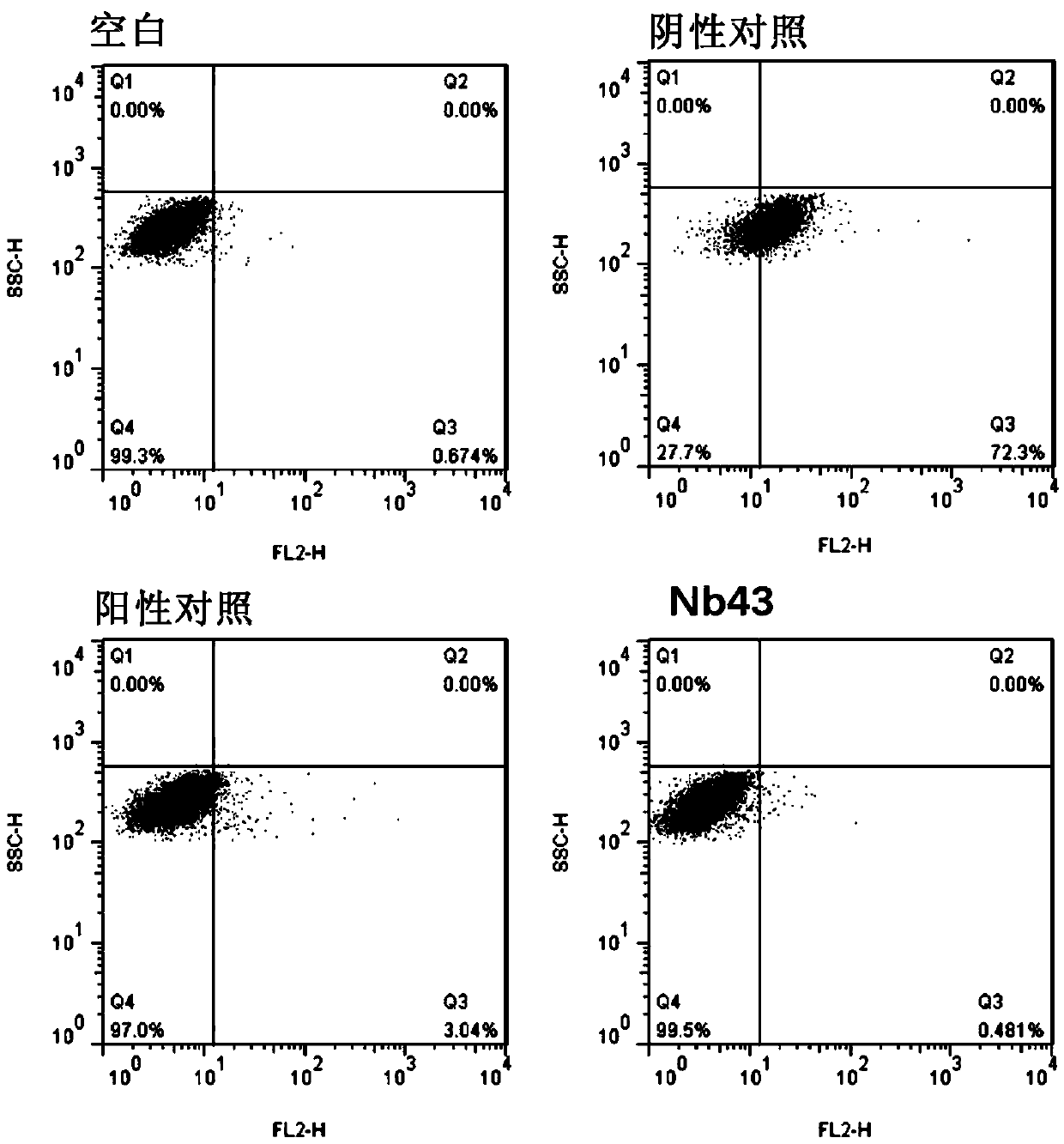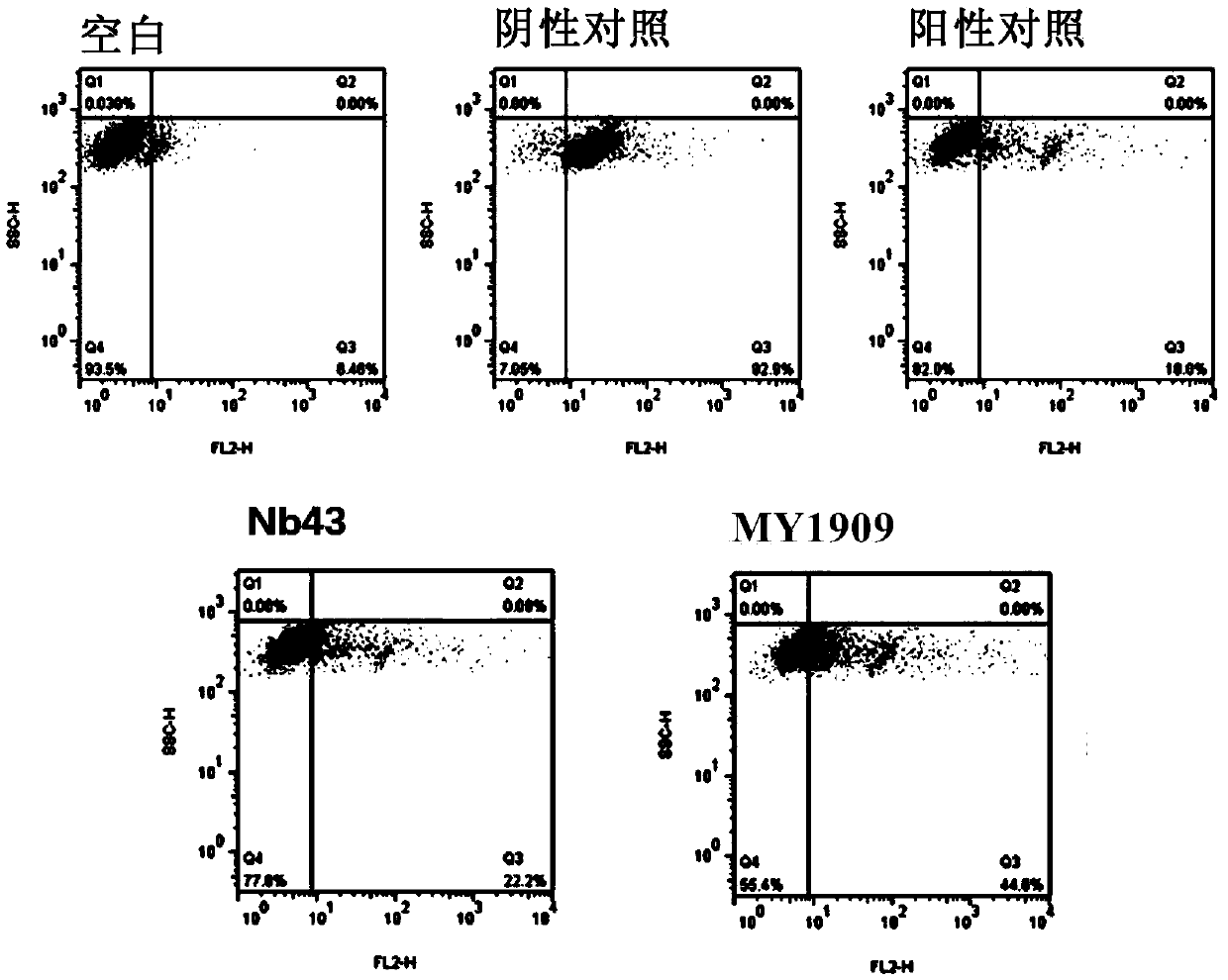Humanized nanometer antibody resistant to PD-L1 and application thereof
A PD-L1, nanobody technology, applied in the field of biomedicine or biopharmaceuticals, can solve problems such as reduced T cell immune effect
- Summary
- Abstract
- Description
- Claims
- Application Information
AI Technical Summary
Problems solved by technology
Method used
Image
Examples
Embodiment 1
[0166] Example 1: Expression and purification of human PD-L1 protein
[0167] (1) The nucleotide sequence of human PD-L1 was synthesized on the pCDNA3.1(-) vector, and then its extracellular segment sequence was subcloned into the pFMSE-IgG1 vector;
[0168] (2) Extract the constructed pFMSE-IgG1-hPD-L1 (ECD) plasmid with the Omega plasmid extraction kit;
[0169] (3) Culture HEK293F cells to an OD of 2.0×10 6 a / mL;
[0170] (4) Mix the plasmid and the transfection reagent PEI 1:3 evenly, let it stand for 10 minutes, and then add it to HEK293F cells at 37°C, 6% CO 2 Cultivate in a shaker incubator for 5-6 days;
[0171] (5) Cell supernatant was collected and combined with Protein A beads for 1 h at room temperature;
[0172] (6) After washing the beads with phosphate buffer solution pH 7.0, the protein was eluted with 0.1M pH 3.0 Glycine;
[0173] (7) Ultrafilter the eluted protein into PBS, measure the yield and take a sample for SDS-PAGE to test the purity of the antigen,...
Embodiment 2
[0175] Example 2: Construction of PD-L1 Nanobody Library
[0176] (1) Mix 1 mg of hPD-L1(ECD)-Fc antigen with Freund's adjuvant in equal volume, immunize a Xinjiang Bactrian camel once a week, and immunize 3 times in total to stimulate B cells to express antigen-specific nanobodies ;
[0177] (2) After the 3 times of immunization, extract 100mL camel peripheral blood lymphocytes and extract total RNA;
[0178] (3) Synthesize cDNA and amplify VHH by nested PCR;
[0179] (4) Digest 20 μg of pMECS phage display vector (supplied by Biovector) and 10 μg of VHH with restriction enzymes Pst I and Not I and connect the two fragments;
[0180] (5) The ligation product was transformed into electroporation-competent cells TG1, and the PD-L1 nanobody library was constructed and the storage capacity was determined. The storage capacity was 1.0×10 9 CFU;
[0181] At the same time, 24 clones were randomly selected for colony PCR detection, and the results showed that the insertion rate o...
Embodiment 3
[0182] Example 3: Screening and Identification of PD-L1 Nanobodies
[0183] Antibody Screening:
[0184] (1) Dissolve in 100mM NaHCO 3 , 10 μg hPD-L1(ECD)-Fc antigen (10 μg Fc inNaHCO 3 As a control) was coupled on a NUNC microtiter plate and placed overnight at 4°C;
[0185] (2) Add 100 μL 0.01% BSA the next day, and block at room temperature for 0.5 h;
[0186] (3) After 2h, add 100μL phage (2×10 11 CFU immunized camel nanobody phage display gene library), at room temperature for 0.5h;
[0187] (4) Wash 5 times with 0.05% PBS+Tween-20 to wash off non-specific phage;
[0188] (5) Dissociate the phage that specifically binds to PD-L1 with 100mM triethanolamine, infect Escherichia coli TG1 cells in the logarithmic phase, and culture at 37°C for 1 hour to generate and purify the phage for the next round of screening , the same screening process was repeated for 3 rounds, and the enrichment factors were no enrichment, 11.4 times and 270 times respectively.
[0189] Use pha...
PUM
 Login to View More
Login to View More Abstract
Description
Claims
Application Information
 Login to View More
Login to View More - R&D
- Intellectual Property
- Life Sciences
- Materials
- Tech Scout
- Unparalleled Data Quality
- Higher Quality Content
- 60% Fewer Hallucinations
Browse by: Latest US Patents, China's latest patents, Technical Efficacy Thesaurus, Application Domain, Technology Topic, Popular Technical Reports.
© 2025 PatSnap. All rights reserved.Legal|Privacy policy|Modern Slavery Act Transparency Statement|Sitemap|About US| Contact US: help@patsnap.com



